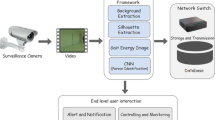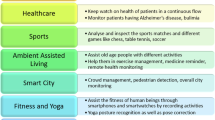Abstract
These days’ security plays the greatest role in order to provide safe platforms and surveillance becomes the essential need to provide accurate results in case of security breach. Gait recognition is a biometric technique that does not need human intervention. Through this technique, human can be uniquely identified. Gait is defined as the way human walks (human locomotion) and this can be used as biometric identity because the manner in which every person walks can uniquely categorize person. But there are many challenges like variation in viewpoints, clothing variations, carrying conditions and so on. A novel approach using deep learning is proposed to address this challenge. To address these limits, we give an idea of having multi-view gait-based recognition system, to provide robust system that is capable of handling one camera and subject walking on different angles from 0° to 180° of view. To achieve the results 3D CNN-based model is used in order to obtain spatio-temporal features. Also, the computation capability of algorithm has been enhanced via transfer learning mechanism. To carry out the experiments, OU-ISIR and CASIA-B dataset are used. Once these features are obtained, these are passed into LSTM network to obtain the long-term dependencies from gait sequence. Network is trained and tested and experiment result shows the proposed technique in this paper outperforms the state of art techniques.
Access this chapter
Tax calculation will be finalised at checkout
Purchases are for personal use only
Similar content being viewed by others
References
M. Alotaibi, A. Mahmood, Improved gait recognition based on spe- cialized deep convolutional neural network. Comput. Vis. Image Underst. 164, 103–110 (2017)
K. Bashir, T. Xiang, S. Gong, Gait recognition without subject cooper-ation. Pattern Recogn. Lett. 31, 2052–2060 (2010)
M. Deng, C. Wang, T. Zheng, Individual identification using a gait dynamics graph. Pattern Recog. (2018)
M. Hofmann, G. Rigoll, Exploiting gradient histograms for gait-based person identification, in 2013 20th IEEE International Conference on Image Processing (ICIP) (IEEE, 2013), pp. 4171–4175
H. Iwama, M. Okumura, Y. Makihara, Y. Yagi, The ou-isir gait database comprising the large population dataset and performance evaluation of gait recognition. IEEE Trans. Inf. Forensics Secur. 7, 1511–1521 (2012)
K. Shiraga, Y. Makihara, D. Muramatsu, T. Echigo, Y. Yagi, Geinet: view-invariant gait recognition using a convolutional neural network, in 2016 International Conference on Biometrics (ICB) (IEEE, 2016), pp. 1–8
D. Thapar, G. Jaswal, A. Nigam, V. Kanhangad, Pvsnet: palm vein authentication siamese network trained using triplet loss and adaptive hard mining by learning enforced domain specific features. arXiv preprint arXiv:1812.06271 (2018)
W. Kusakunniran, Q. Wu, J. Zhang, H. Li, Gait recognition under various viewing angles based on correlated motion regression. IEEE Trans. Circ. Syst. Video Technol. 22, 966–980 (2012)
M. Hu, Y. Wang, Z. Zhang, D. Zhang, J.J. Little, Incremental learning for video-based gait recognition with lbp flow. IEEE Trans. Cybern. 43, 77–89 (2013)
J. Yang, J.Y. Yang, Why can LDA be performed in PCA transformed space? Patt. Recogn. 36(2), 563–566 (2003)
P.N. Belhumeur, J.P. Hespanha, D.J. Kriegman, Eigenfaces vs. fisherfaces: recognition using class specific linear projection. IEEE Trans. Patt. Anal. Mach. Intell. 19(7), 711–720 (1997)
C. Liu, H. Wechsler, Robust coding schemes for indexing and retrieval from large face database. IEEE Trans. Image Process. 9(1), 132–137 (2000)
B.S. Venkatesh, S. Palanivel, B. Yegnanarayana, Face detection and recognition in an image sequence using eigenedginess, in Proceedings of Indian Conference on Computer Vision, Graphics Image Process (2002), pp. 97–101
S. Fidler, A. Leonardis, Robust LDA classification by subsampling, in Proceedings of International Workshop Statistical Analysis Computer Vision (2003), pp. 97–104
T. Kanungo, D.M. Mount, N.S. Netanyahu, C.D. Piatko, R. Silverman, A.Y. Wu, An efficient k-means clustering algorithm: analysis and implementation. IEEE Trans. Patt. Anal. Mach. Intell. 24(7), 881–892 (2002)
Author information
Authors and Affiliations
Corresponding author
Editor information
Editors and Affiliations
Rights and permissions
Copyright information
© 2021 Springer Nature Singapore Pte Ltd.
About this paper
Cite this paper
Parashar, A., Parashar, A., Aski, V., Shekhawat, R.S. (2021). Surveillance System to Provide Secured Gait Signatures in Multi-view Variations Using Deep Learning. In: Patnaik, S., Yang, XS., Sethi, I. (eds) Advances in Machine Learning and Computational Intelligence. Algorithms for Intelligent Systems. Springer, Singapore. https://doi.org/10.1007/978-981-15-5243-4_21
Download citation
DOI: https://doi.org/10.1007/978-981-15-5243-4_21
Published:
Publisher Name: Springer, Singapore
Print ISBN: 978-981-15-5242-7
Online ISBN: 978-981-15-5243-4
eBook Packages: EngineeringEngineering (R0)




